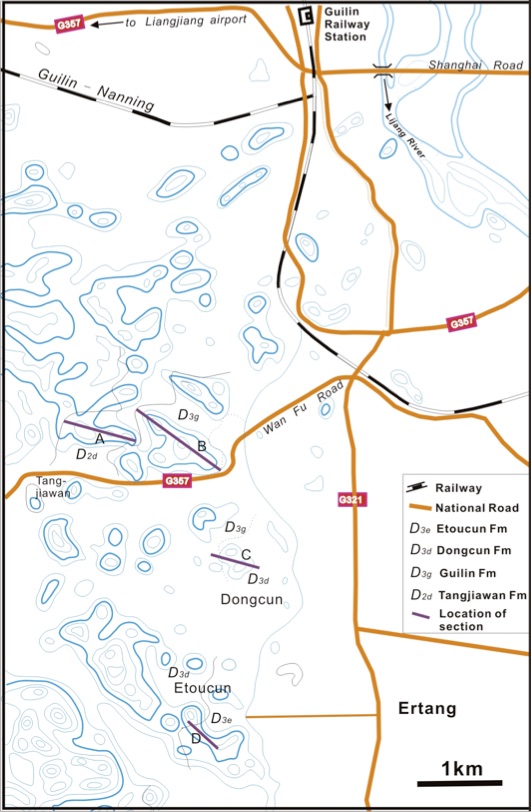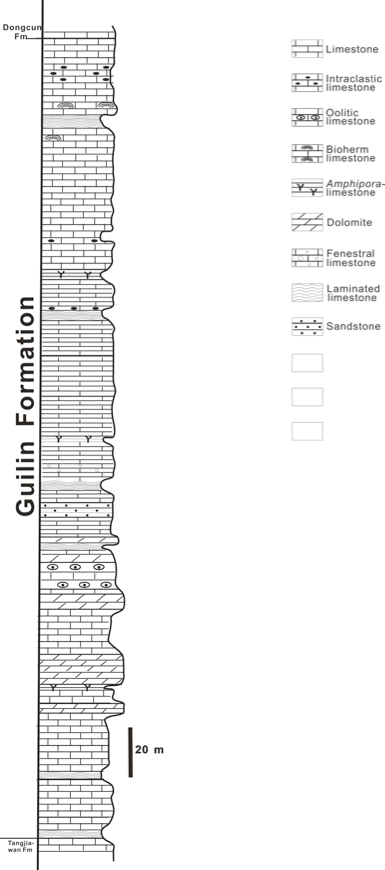Guilin Fm
Type Locality and Naming
It was named by Feng Jinglan in 1929, and no type section was given. Chao K.K. (=Zhao Jingke) revised the name as “Kuilin Limestone” representing the deposits bearing-Cyrtospirifer of Upper Devonian at Laorenshan (Hill) of Guilin City in 1947. A selected reference section was proposed by Wu Yi et al. (1992) near the locality of Tangjiawan Fm (25°13′05″N—110°15′45″E.).
Synonym: Kuilin Fm
[Figure - Topographical map of the southern suburb of Guilin City, Guangxi showing the type localities of the Tangjiawan Fm (A), Guilin Fm (B), Dongcun Fm (C) and Etoucun Fm (D).]
Lithology and Thickness
Limestone. The Guilin Formation is marked by the development of carbonate rocks. Generally it consists of dark-gray to grayish-black medium- to thick-bedded micritic bioclastic limestone, dolomitic limestone and fine-grained dolomite. Some microfacies and sedimentary cycle sequences are recognized. The main microfacies include stromatopora-echinoderm packstone/grainstone, echinoderm packstone, Amphipora-grainstone, Amphipora-echinoderm packstone/floatstone, ooid-peloid grainstone. [Amphipora is a stromatopora]. The sparry bioclastic packstone-peloid grainstone cycle occurred in the lower and middle parts and the Amphipora-echinoderm packstone/floatstone -mudstone cycles commonly appeared in the upper part of the formation. It is 320 to 500 m in thickness.
[Figure - Column section of Guilin Formation in the type locality of Tangjiawan, Guilin City (After Knacksledt, M. et al., 1993).]
Relationships and Distribution
Lower contact
The lower part with the dark-gray laminated limestone at the base rests conformably on the stromatopora-bearing dolomite of the Donggangling Fm (Tungkangling Fm), or the Baqi Fm, depending on location.
Upper contact
This formation is overlain by the light-gray limestone of the Dongcun Fm; or oolitic limestone of Rongxian Fm; or pelagic marl of Wuzhishang Fm, depending on location.
Regional extent
This formation is widely distributed in Huanjiang, Luocheng, Rong’an, Quanzhou, Guilin, Lingchuan, Lingui, Yangshuo, Yongfu of northern Guangxi, in Fuchuan, Hexian, Zhongshan of northeast Guangxi.
This formation is intercalated with dolomite and minor breccia limestone at its bottom in east of Hexian. In Quangzhou, it is 356-577 m in thickness and intercalated with oncolite-bearing limestone. There are many intercalations of dolomitic limestone and dolomites, 633 m thick totally, in Yongfu and Luocheng. In Longyan of Huanjiang and Dongxing.
GeoJSON
Fossils
Stromatoporoid are common with Paramphypora blokhini, P. pervisiculata, P. tschussovensis, Actinistroma clathrathum in the lower and Clathrostroma sp., Stictostroma sp., Hammatostroma delicatulum in the upper. Brachiopods Cyrtospirifer sp., Tenticospirifer sp. and Atrypa sp. are mainly seen in the upper part.
Age
Depositional setting
A restricted shallow water environment with short tempestites is interpreted. The evaporites and early digenetic dolomites are absent, which indicates that the shallow subtidal and tidal flat deposition underwent meteoric influence.
Additional Information

